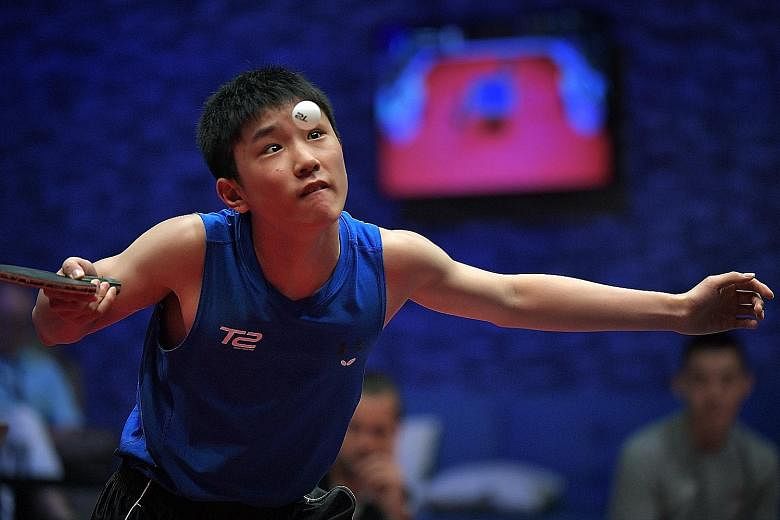After Singapore's sensational triumph at the world table tennis championships in 2010, pictures of Feng Tianwei and Co celebrating as victors - contrasted against the dejection of the defeated Chinese paddlers - were put up at the Chinese national training centre.
That showed China's intention to avenge a defeat few saw coming or even thought possible, but also reflected who the table tennis superpower viewed as threats.
Word has it that the third floor of the Beijing facility has been redecorated. Two new LCD screens have been put up - one displaying a photo of Japan teenager Miu Hirano, the other playing the 17-year-old's matches on loop.
The message is clear. Japan is now seen as the biggest challenger to China's dominance.
As hosts of the next Olympics in Tokyo, the Japanese could break new ground in 2020 by winning their first table tennis gold at the quadrennial Games.
Even more so, given the recent addition of mixed doubles - an event in which Kasumi Ishikawa and Maharu Yoshimura became world champions earlier this month - to the schedule.
-
JAPAN'S TEENAGE PRODIGIES
-
 Above: Japan´s Miu Hirano, 17, won the women's singles title at the Asian championships in Wuxi in April. PHOTO: AGENCE FRANCE-PRESSE
Above: Japan´s Miu Hirano, 17, won the women's singles title at the Asian championships in Wuxi in April. PHOTO: AGENCE FRANCE-PRESSE MIU HIRANO
AGE: 17 WORLD RANKING: 7
NOTABLE ACHIEVEMENTS
• Oct 2016: Youngest to win Women's World Cup (16 years old)
• April 2017: Youngest to win Asian Championships (17 years old), beating three Chinese in a row - world No. 1 Ding Ning, No. 2 Zhu Yuling and No. 5 Chen Meng
-
MIMA ITO
AGE: 17 WORLD RANKING: 10
NOTABLE ACHIEVEMENTS
• March 2014: Won the German Open doubles title (with Hirano) to become youngest ever doubles winners (13 years old) on tour
• March 2015: Youngest singles champion (14 years old) on ITTF tour, winning the German Open
• Aug 2016: Youngest table tennis medallist at the 2016 Olympics, winning bronze in the women's team event
-
 Tomokazu Harimoto with a cake for his 14th birthday on Tuesday as the world's best table tennis players sing behind him. - ST PHOTO: KUA CHEE SIONG TOMOKAZU HARIMOTO
Tomokazu Harimoto with a cake for his 14th birthday on Tuesday as the world's best table tennis players sing behind him. - ST PHOTO: KUA CHEE SIONG TOMOKAZU HARIMOTO AGE: 14 WORLD RANKING: 39
NOTABLE ACHIEVEMENTS
• June 2016: Youngest winner of Under-21 event on ITTF tour (12 years old)
• Dec 2016: Youngest champion at world junior championships (13 years old)
• June 2017: Youngest quarter-finalist at world championships (13 years old)
"Japan has invested a lot into developing their own players and have always proven that they don't need any talents from China," two-time world champion Jiang Jialiang told The Straits Times this week in Johor Bahru at the launch of T2 Asia-Pacific, a new league that features 24 of the world's top players. The former Chinese paddler is captain of one of four teams.
"What you see now is the result of work that was started from 10 to 15 years ago," he added.
The Japanese have put an emphasis on youth development - said to have been sparked after hosting the 2001 world championships in Osaka - building a framework since unearthing the likes of two-time Olympic medallist Ai Fukuhara and world No. 6 Jun Mizutani.
The Japan Table Tennis Association reportedly spends more than three billion yen (S$36.8 million) a year on the sport, a third of which is allocated to youth development.
Table tennis is also one of the sports backed by the Japan Olympic Committee's Elite Academy Programme, a concerted national effort to groom future world beaters at its state-of-the-art National Training Centre in Tokyo.
Their push has led to a steady stream of starlets emerging, adding depth to a team that already comprises established names.
The threat they pose is so real that the Chinese team reportedly now have four sparring partners whose sole job is to mimic World Cup and Asian championships winner Miu's playing style in training.
Said world No. 8 German Timo Boll, who was part of the team that lost 1-3 to Japan in last year's Olympic semi-finals: "They have a very good system. Their players push themselves, practise more than before and we (Germany) are in a little bit of danger. We've already lost the No. 2 position behind China to Japan."
The signs suggest that come 2020, Japan could become just the third nation apart from China to stand atop the Olympic podium. Only South Korea (three) and Sweden (one) have won golds, with China taking 28 of the 32 Olympic titles so far.
But most say that while it is not mission impossible, it will remain a difficult one.
World No. 1 and Olympic champion Ding Ning wrote off Japan's home advantage in three year's time. "The world (team) championships were held in Japan in 2014 too," she said, noting China won both the men's and women's team golds that year.
"I don't think it will make much of a difference. It may mean greater convenience and comfort for the Japanese, but China won't have to travel that far to get there either. We've adjusted well to playing anywhere in the world over the years.
"Japan has invested manpower and resources into table tennis, so naturally they are reaping some rewards. But China also has a considerable backing for 2020."
Added Jiang: "The competition will be stiffer at the Olympics in 2020, especially in the mixed doubles event.
"It's not impossible for Japan to win a gold, but whether or not they can do it in China's usual dominating fashion is another question."
And while it may seem like China does not seem to be faring as well in producing young talent, veterans like Vladimir Samsonov remain wary of the Chinese conveyor belt.
The Belarusian, who at his sixth straight Olympics last year made the semi-finals of the singles event, said: "There are only a few players who represent China on the international stage, while there could be 10-15 that play for Japan and they get a lot more opportunities to play.
"We don't know how many good players there are in China because we don't see them. But there are so many players who could be top 20 in the world. I'm sure they have good young players - they just don't compete internationally as much."


